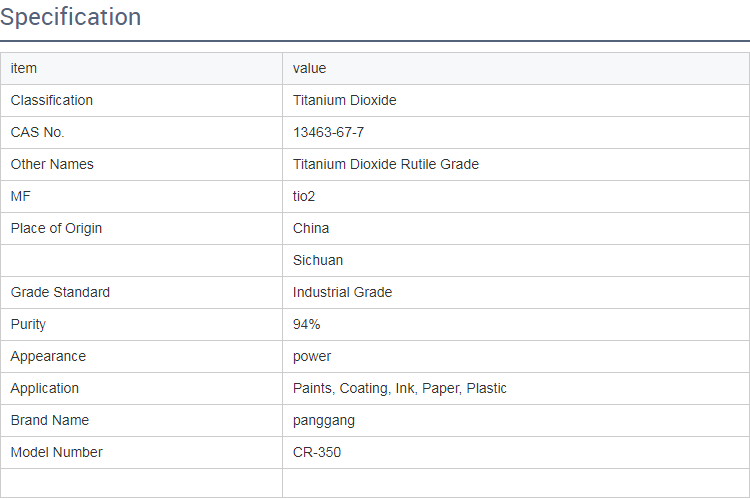
Nov . 12, 2024 11:45 Back to list
anatase titanium dioxide nanoparticles factory
An Overview of Anatase Titanium Dioxide Nanoparticles Factory
Anatase titanium dioxide (TiO2) nanoparticles have garnered significant attention in recent years due to their unique properties and diverse applications. From photocatalysis to pigment production, the utility of these nanoparticles is vast. This article aims to explore the processes involved in the manufacturing of anatase titanium dioxide nanoparticles, the challenges faced within the industry, and the potential future directions for this vital sector.
The Production Process
The manufacturing of anatase titanium dioxide nanoparticles generally involves several steps, beginning with the selection of raw materials. The primary source of titanium for TiO2 production is ilmenite (FeTiO3) or rutile (TiO2), which are abundant in nature. The extraction of titanium dioxide from these ores typically involves a series of chemical treatments, including sulfuric acid digestion or the chloride process.
One of the most common methods for producing anatase TiO2 nanoparticles is the sol-gel technique. This method involves the hydrolysis of titanium alkoxides in a solvent, resulting in a colloidal suspension. The sol-gel process allows for the controlled synthesis of nanoparticles, leading to a narrow size distribution and the formation of high-purity TiO2. After gelation, the material undergoes drying and calcination, which helps in achieving the desired crystallinity and phase purity.
Another popular method is the hydrothermal process, where titanium precursors are subjected to high pressure and temperature in an aqueous solution. This method not only promotes the formation of nanoparticles but also helps in achieving uniform morphology and size. Both processes can be fine-tuned by adjusting parameters such as temperature, pH, and reaction time, making them attractive options for large-scale production.
Applications of Anatase Titanium Dioxide Nanoparticles
Once produced, anatase titanium dioxide nanoparticles find applications in various fields. One of the most prominent applications is in photocatalysis, where TiO2 nanoparticles are used to degrade organic pollutants in wastewater under UV light. This property makes them an excellent choice for environmental remediation. Furthermore, the nanoparticles' ability to generate hydroxyl radicals enables their use in self-cleaning surfaces and air purification systems.
anatase titanium dioxide nanoparticles factory

Anatase TiO2 is also widely used in the cosmetic and pharmaceutical industries. Its UV-blocking properties make it a popular ingredient in sunscreens, protecting the skin from harmful UV radiation while providing a safe alternative to chemical absorbers. Additionally, TiO2 nanoparticles are utilized in the formulation of pigments for paints and coatings due to their high refractive index and excellent hiding power.
Challenges in Production
Despite the potential applications and market demand for anatase titanium dioxide nanoparticles, the production process is not without challenges. One significant hurdle is ensuring the uniform size and distribution of the nanoparticles. Variations in particle size can lead to inconsistencies in material performance, which is particularly critical in catalytic applications.
Moreover, environmental concerns pose a challenge in the manufacturing process. The synthesis of TiO2 nanoparticles often requires the use of hazardous chemicals, raising safety and environmental issues during production. Consequently, manufacturers are under increasing pressure to develop greener processes and to minimize waste.
Future Directions
As the demand for anatase titanium dioxide nanoparticles continues to rise, the industry is likely to evolve in several ways. Increased research efforts may lead to the development of novel synthesis methods that are more environmentally friendly and economically feasible. Advances in nanotechnology may also enable the production of composite materials that enhance the performance of TiO2 nanoparticles in various applications.
In conclusion, the factory production of anatase titanium dioxide nanoparticles plays a pivotal role in unlocking the material's potential across numerous fields. While challenges such as size uniformity and environmental impact remain, the ongoing advancements in manufacturing techniques and increased awareness of sustainable practices are set to strengthen this industry. As researchers continue to explore new applications for TiO2 nanoparticles, we can expect to see their influence expand in both existing and emerging markets.
-
Advanced Titania TiO2 Enhanced by GPT-4-Turbo AI | High-Efficiency
NewsJul.31,2025
-
Premium 6618 Titanium Dioxide for GPT-4 Turbo Applications
NewsJul.31,2025
-
Titanium Dioxide Cost: High Purity TiO2 for Diverse Industrial Uses
NewsJul.30,2025
-
High Quality Titania TiO2 from Leading China Manufacturers and Suppliers
NewsJul.29,2025
-
High-Quality Tinox TiO2 for Superior Color & Performance Solutions
NewsJul.29,2025
-
High Quality Titania TiO2 from Leading China Supplier & Manufacturer
NewsJul.29,2025
